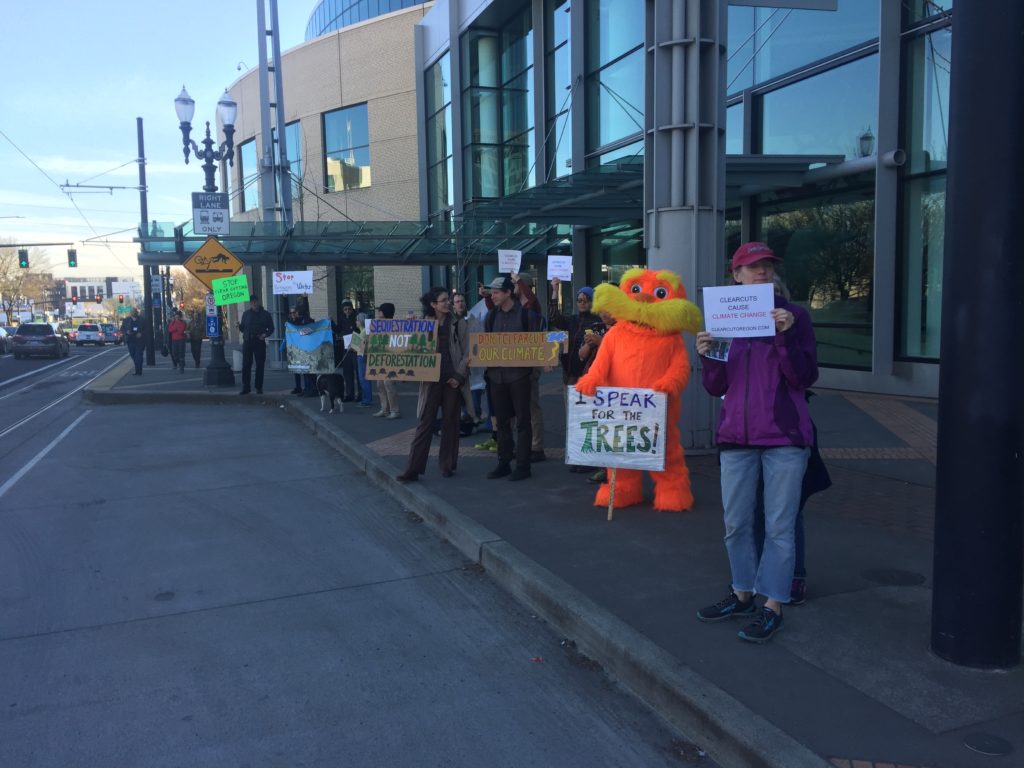
In the end, the orange-coated Lorax protesting outside the 2018 International Mass Timber Conference was not the most surprising development that March morning in Portland, Oregon.
That came when I visited with the protest’s organizer and asked why Oregon Wild opposes the construction of mass timber buildings.
He explained: “We aren’t necessarily opposed to using wood, it can be good. We are opposed to how it is harvested. We are opposed to clearcuts.”
And then: “Recent research shows that the benefits of using wood compared to fossil fuel-intensive materials have been overestimated by an order of magnitude.”
Wow.
An error of 10 times is enormous in the research world. Being off by two times (or 100 percent) is large, but this would mean an error of 1,000 percent.
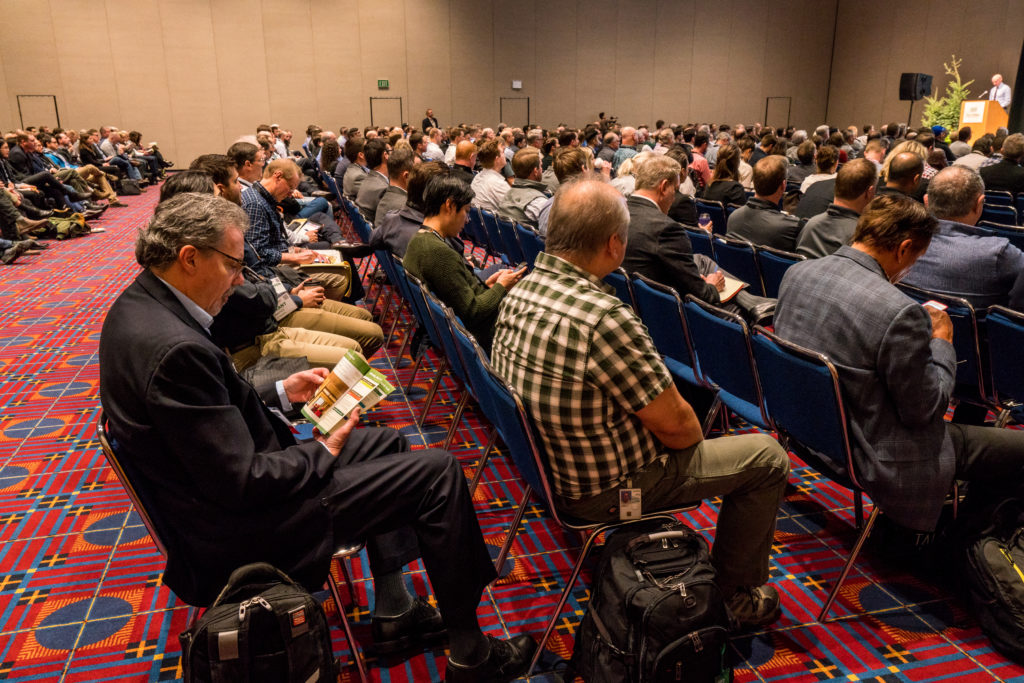
The protest leader’s statement came in stark contrast to the presentations inside the conference hall by architects, foresters, Life Cycle Assessment (LCA) specialists and others.
While the protesters claimed the Lorax as an advocate for leaving trees in the forest to save the planet, those inside the hall advocated storing carbon in buildings in the form of wood products derived from sustainably managed forests.
The mass timber advocates spoke of planting and replacing the trees used in wooden high-rises. They spoke of saving the environment by avoiding the release of greenhouse gas emissions from the fossil carbon used to manufacture steel, concrete, brick and aluminum.
After the conference, I talked with Sean Stevens, executive director of Oregon Wild. He had attended the conference with a free pass provided by the event’s organizer, the Forest Business Network, to encourage dialogue between wood users, producers and the protesters.
Stevens repeated the assertion of the protest leader, which I learned they pulled from an academic paper published by researchers at Oregon State University and the University of Idaho. It was clearly an important sound bite for the group.
So too was this statement from the same report, which contended that mass timber buildings “are generally assumed to outlive their usefulness or be replaced within several decades.”
Now, based on the work of Law et al., Oregon Wild is advocating that storing more carbon in forests is better than using wood in buildings as a strategy to mitigate climate change.
People who are deeply invested in the well-being of their community and world often come to different conclusions about the best course of action.
But how could researchers come to such wildly different conclusions on the carbon effect of wood products? This led me to a series of interviews and multiple other sources to sort through a rabbit warren of questionable assumptions and conclusions in the OSU researchers’ paper.

To cut or not to cut?
Whether to sustainably cut forests is truly a global existential question. Earth’s growing population and the greenhouse gas emissions typical of modern life make our forest management choices critical to our climate change trajectory.
Forests have a phenomenal capacity to capture and store carbon for long periods of time. It is no idle question, then, to investigate whether it is more effective to leave forests alone to grow and store carbon, or to sustainably grow, harvest and use wood products in place of fossil fuel-intensive products like steel and concrete.
The research paper cited by Oregon Wild’s leaders was published by Beverly Law and others in Proceedings of the National Academy of Sciences, March 2018. It examines different land use strategies to mitigate climate change in temperate forests.
The authors’ basic conclusion is this: By growing forests longer without cutting them, you can store more carbon. They propose doubling the rotation age from 40 years to 80 years on private lands, and halving the harvest on national forests in Oregon. They also suggest their approach can be applied to other temperate regions.
After its publication, the paper – and its call for no cutting – was the basis for a High Country News report, “Timber is Oregon’s biggest carbon polluter.”
But how did the OSU team reach their conclusion and why do other scientists strongly disagree? It boils down to whether they made reasonable assumptions.
The controversy – and the paper itself – demonstrates a divide among the science, environmental advocacy and conservation communities on the appropriate path forward for public policy.
Who should make policy decisions and what information should they be based on? We often look to scientific research to help sort through these issues.
And what do we do with science that seems contradictory? The High Country News story reported on the OSU researchers’ conclusions, but did not vet the claims with other scientists. And advocacy groups are now recommending policy changes based on the contested report and its findings.
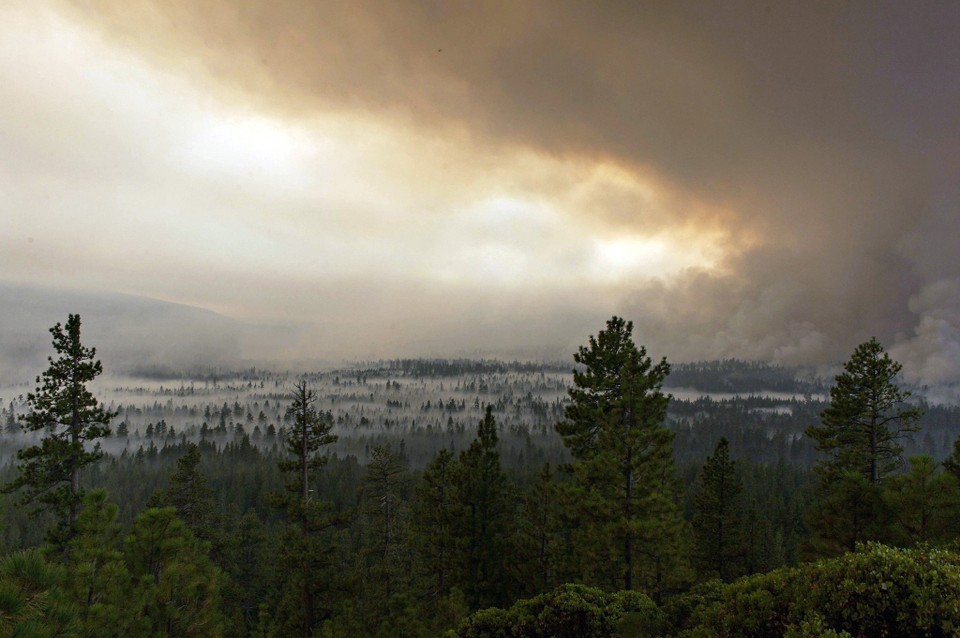
Science is a process, not a result
Science isn’t flawless. It is a human institution and humans are flawed. We all have biases, both conscious and unconscious, which are woven into the fabric of our thought processes.
However, science has built-in processes to filter out human shortcomings. For example, international bodies collaborate to develop and critically review standardized procedures to remove as much of the personal biases as possible.
The scientific method requires authors to publish their methods so others can test them and replicate the results. The science community also uses reviews by anonymous peer experts so the reviewers are free to provide critiques and question authors without personal repercussions.
Science is an iterative, incremental learning process intended to be open and transparent. The goal is to reveal solid, factual information. Still, the journey toward that goal can be convoluted.
Social and psychological research shows that unconscious biases can creep into the thinking process in multiple ways. So another approach to sorting out apparently conflicting information, in addition to established scientific processes, is to apply Occam’s Razor, a principle from philosophy developed about 800 years ago.
It says: When there are two possible explanations, the simpler one is the more likely. Another way of saying it is: The more assumptions you must make, the more unlikely the explanation.
That brings us to the crux of the issue raised by the OSU scientists’ paper and Oregon Wild’s use of it: What is the balance between the sustainable harvest and use of wood to replace fossil fuel-intensive materials like steel, concrete, aluminum and brick versus leaving some forests untouched for long periods of time to store the carbon in live and dead trees?
Make assumptions with care
Did the scientific process break down in the review – or lack of review – given this paper and its assumptions and conclusions?
The problems that surfaced in the Law paper include:
- The quote used by Oregon Wild can’t be found in the references cited.
- The calculation used to justify doubling forest rotations assumes no leakage. Leakage is a carbon accounting term referring to the potential that if you delay cutting trees in one area, others might be cut somewhere else to replace the gap in wood production, reducing the supposed carbon benefit.
- The paper underestimates the amount of wildfire in the past and chose not to model increases in the amount of fire in the future driven by climate change.
- It assumes a 50-year half-life for buildings instead of the minimum 75 years the ASTM standard calls for, which reduces the researchers’ estimate of the carbon stored in buildings.
- It assumes a decline of substitution benefits, which other LCA scientists consider as permanent.
- It models just one species of insect to account for tree mortality when there are a variety of insect and diseases which impact forest carbon capture and storage. And the insect mortality modeled was unrealistic.
- The OSU scientists assumed wood energy production is for electricity production only. However, the most common energy systems in the wood products manufacturing sector are combined heat and power (CHP) or straight heat energy production (drying lumber or heat for processing energy) where the efficiency is often two to three times as great and thus provides much larger fossil fuel offsets than the modeling allows.
- The researchers claim to conduct a Life Cycle Assessment (LCA), but fail to use the international standards for conducting such analyses, without explaining this difference in methods.
- The peer reviewers did not include an LCA expert.
- The claimed significance of substantial carbon savings from delaying harvest and the large emission numbers from the forest products sector are undermined by all of the above.
As part of the IMTC 18 conference, OSU professors hosted a tour of the new forestry building under construction using mass timber, where they indicated the powerful carbon benefits of using wood.
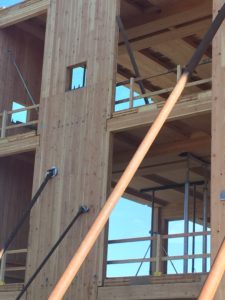
Dr. Maureen Puettmann, an LCA specialist, a courtesy faculty member at OSU and the director of operations with CORRIM, indicated multiple issues with the Law paper, many of which are included on the list above.
Trying to sort through the issue of quality control on research papers, I asked Dr. Anthony Davis, acting dean of the Oregon State University School of Forestry (the lead author’s home institution), how he resolves conflicting research results coming from within the same school.
Davis indicated: “It isn’t the role of the dean to resolve these differences, but rather to ensure that all of our faculty are able inform an ongoing dialogue through replicable research practices. Then, the peer-review process of scientific publications is critical to ensure that the assumptions made in a particular project are clearly stated and reasonable relative to the outcomes of that work.”
He added, “Researchers often explore extremes of a subject on purpose, to help define the edges of our understanding; or other studies might only examine one aspect of an issue which in reality does not occur in a vacuum. It is important to look at the whole array of research results around a subject rather than using those of a single study or publication as a conclusion to a field of study.”
The decision would be challenging enough if carbon were the only issue, but it isn’t.
There are myriad other benefits that forests provide society besides carbon. Water quality and quantity, places to recreate, balancing wildfire risks to lives, property and the diversity of habitat for animals are a few of the benefits to be considered.
In addition, the material for the cardboard boxes that deliver goods to our houses or the store where we shop, as well as the wood most of our homes are built from, come from forests.
Should the offices and manufacturing plants where we work be made of wood in the future? These various objectives can be in conflict with each other.
Davis, the acting OSU forestry dean, recognizes these complexities and encouraged me to visit directly with PNAS about their scholarly review process – and with Dr. Law and Dr. Harmon, the authors on OSU’s faculty. He said he would encourage them to visit with me.
Meanwhile, back at IMTC
The Occam’s razor answer to the carbon question was encapsulated by Alan Organschi, a practicing architect, a professor at Yale and one of the founders of TimberCity.org. He was among the presenters at IMTC 18.
When I asked about the benefits of substituting wood for steel or concrete and the variation in the magnitude of the benefits, Organschi emphasized that he isn’t an LCA specialist or scientist and then offered his thought process: “There is a huge net carbon benefit [from using wood] and enormous variability in the specific calculations of substitution benefits. We don’t have time to wait for precision, we have to use our best judgment.”
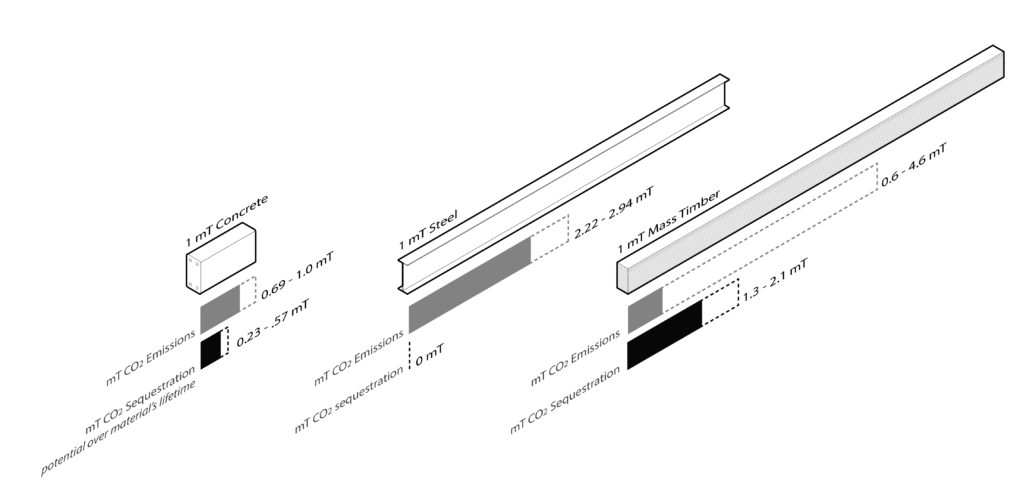
In the construction world, Organschi said, a ton of wood (which is half carbon) goes a lot farther than a ton of concrete, which releases significant amounts of carbon during a building’s construction.
And remember: We only have about 18 years to change our fossil energy use to avoid exceeding the 450 ppm of carbon in the atmosphere that would produce a 2-degree temperature increase.
Organschi went on to paraphrase Dr. James Hansen, the former NASA climate scientist who has been vocal about climate change since early in its research history. In the late 1980’s he said, “Quit using high fossil fuel materials and start using materials that sink carbon, that should be the principle for our decisions.”
For Organschi, the choice of wood is obvious.
In 2007, the International Panel on Climate Change (IPCC) acknowledged the importance of sustainable forest management and wood products as essential to solving the carbon problem associated with climate change.In other words, if you don’t grow it, you mine it.
If Organschi’s answer doesn’t satisfy, read on.
This topic is being examined all across the world. In December of 2017, a policy paper was published in the European Union (EU) calling for changes to almost double the mitigation effects by EU forests through Climate Smart Forestry (CSF).
“It is derived from a more holistic and effective approach than one based solely on the goals of storing carbon in forest ecosystems,” the paper said. “The core of CSF is that it considers the whole forest and wood products chain, including material and energy substitution.”
Climate Smart Forestry would encourage the use of wood through tax exemptions or by taxing the fossil CO2 created by using steel, aluminum and concrete, as well as the education of builders and architects in wood construction.
In addition, a number of basic principles were shared by presenters at the IMTC 18 – TimberCity.org, Architecture 2030, Terrapin Brightgreen, Biomimicry – that can shine light on the controversy:Using more biologically based materials and less geologically based materials is beneficial.
- Biophilia, feeding the human connection to nature and design using the knowledge of how ecosystems function, i.e. biomimicry.
- Plan, design and build for the long-run.
- The Triple Bottom Line of Sustainability, making sure our systems integrate economically, environmentally and socially.
Who said it?
The quote Oregon Wild gave to me isn’t a conclusion of the Law paper or a result of their work. Instead, it is referenced by Law et al. to a previous paper by Harmon and others from 2009. But the quote can’t be found there either.
In the earlier paper, the authors stated, “We did not include the so-called substitution effects of using wood versus other more energy intensive materials for construction.” The closest I could find was a reference to Hennigar and others (2008) that cited substitution values can vary 10-fold.
Hennigar did use substitution benefits and attributed the variation to differences in materials and what product they substituted for. Because of the variation, they chose to model four different levels of benefits to test the sensitivity of their analysis to the variability.
When I asked Harmon about the quote, he indicated that I was not using the correct part of the reference. The order of magnitude difference was related to a logic process he applied when wood buildings are replaced with wood buildings.
His logic says no substitution benefit exists when wood replaces wood. LCA specialists say each time a building is proposed for construction, there is a decision about which kind of materials will be used and thus an opportunity for substitution benefits.
Harmon said the quote was implied by the numbers included in a parenthesis and his logic process. No analysis or methods were presented. This became the basis for the quote and one of the many foundational assumptions for Oregon Wild’s use of the “seminal” results. (See Assumptions Substitution Benefits heading below.)
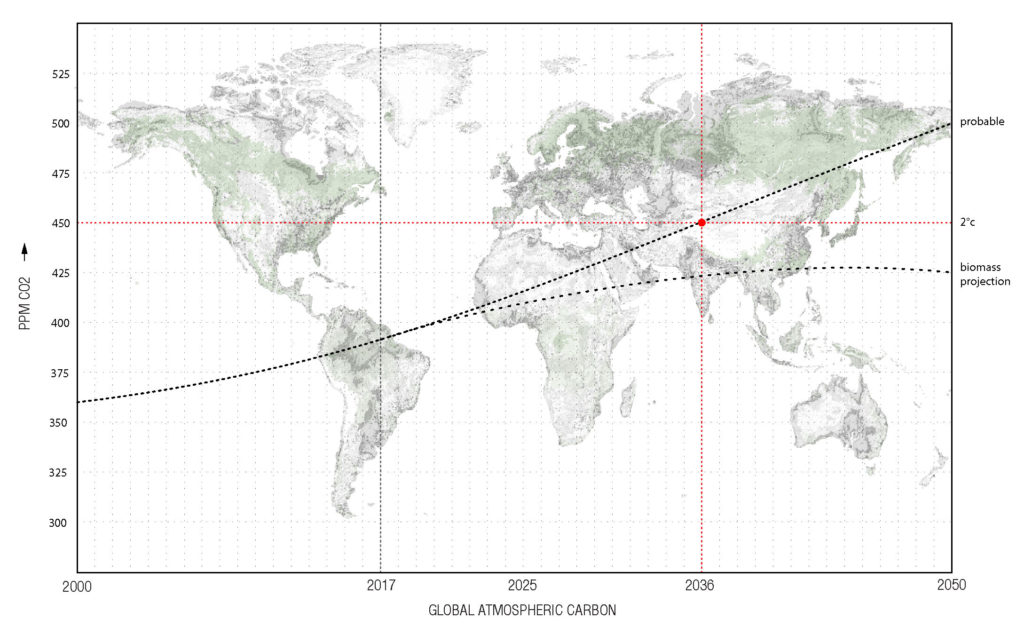
Who is a peer and how do they review?
I talked to Dr. Bill Schlesinger, the editor for PNAS on the Law article, asking about the journal’s peer review process. He indicated they use two reviewers for articles. I asked if either had expertise in LCA, and he said no, he didn’t view that as the primary purpose of the paper so he didn’t select for those skills.
But clearly, the advocacy users and the story in High Country News see it as important, as did the authors themselves, as they state in their conclusions: “Our integrated approach of combining observations, an LCA [emphasis added] … of a suite of potential mitigation actions and their effects on forest carbon sequestration and emissions …”
The peer review was conducted in December 2017. Schlesinger coordinates reviews on five to six papers per month and didn’t recall a lot of the specifics of what the reviewers found when I asked about the wildfires, insects and disease, and building life spans, but said there must not have been problems or the reviewers would have identified them.
However, he did acknowledge that leakage would be expected and would be important to account for. Schlesinger encouraged me to contact Law with my specific questions. I called and emailed her multiple times with no direct response. Eventually, she had Harmon contact me.
I also visited with four people affiliated with the Consortium for Research on Renewable Industrial Materials (CORRIM), which specializes in Life Cycle Assessments (LCA), regarding the paper. CORRIM has 13 university members, the U.S. Forest Service Forest Products Laboratory, a Department of Energy research affiliate, Canadian research, FPInnovations and some wood trade associations.
All four indicated that Law et al. does not meet the minimum elements of a Life Cycle Assessment: system boundary, inventory analysis, impact assessment and interpretation. All four are required by the international standards (ISO 14040 and 14044); therefore, Law et al. does not qualify as an LCA.
Said Elaine Oneil, director of science and sustainability at CORRIM: “The [paper] is nearly opaque with respect to its underlying assumptions, so assessing the validity and accuracy of the simulation modeling effort is onerous. What little is shared in the article regarding inputs to the simulation model ignores the latest developments in wood life cycle assessment and sustainable building design, rendering the results at best inaccurate and most likely incorrect.”

Assumptions – Leakage
Understanding assumptions that go into any analysis is key to the interpretations. To help elucidate the assumptions, I interviewed Dr. Mark Harmon, one of the authors on the team and the primary author of the LCA portion of the paper.
The first time we visited, when I started asking about wildfires and other questions, he indicated I should talk to Dr. Law, as he wasn’t deeply involved in those aspects of the work. When I sent Law a series of questions, I was contacted by Harmon, who said she was too busy and he would address the questions.
The paper assumes there will be no “leakage” in its analysis. Leakage is a term in the carbon accounting world that tries to track changes that may occur as a result of implementing a new carbon conservation measure.
In this case, if all the private land in Oregon almost doubled its rotation it would mean no or little harvest (possibly some thinning) would occur for a 35- to 40-year period as the forests were allowed to grow. No leakage means no other trees would be cut in other locations to replace the supply from private Oregon forests and the reduction from national forests.
Oneil indicated: “The PNAS paper, which asserts that growing our PNW forests indefinitely would reduce the global carbon footprint, ignoresthat at best there would 100 percent leakage to other areas with lower productivity … which will result in 2 to 3.5 times more acres harvested for the same amount of building materials. Alternatively, all those buildings will be built from materials with a higher carbon footprint, so the substitution impact of using fossil-intensive products in place of renewable low carbon would result in >100 percent leakage.”
The paper says “leakage is difficult to quantify” and acknowledges it “could counter these carbon gains,” but provides no analysis to estimate what these losses might be, what the magnitude could be and thus the impact it would have on the conclusions of the paper.
The paper goes on to say, “However, because harvest on federal lands was reduced significantly since 1992 (Northwest Forest Plan), leakage has probably already occurred.”
When the Northwest Forest Plan was implemented in 1994, a precipitous decline in harvest from the national forests occurred, a real-world example of whether leakage is likely to occur under the Law scenario.
In 2001, seven years after implementation, Jack Ward Thomas, one of the architects of the plan and former chief of the U.S. Forest Service, said: “The drop in the cut in the Pacific Northwest was essentially replaced by imports from Canada, Scandinavia and Chile … but we haven’t reduced our per-capita consumption of wood. We have only shifted the source.”
It is hard to imagine a similar scenario would not occur if the proposed harvest reduction on private land were implemented. It seems the Pacific Northwest’s own history could have been used to inform the analysis by Law’s team.
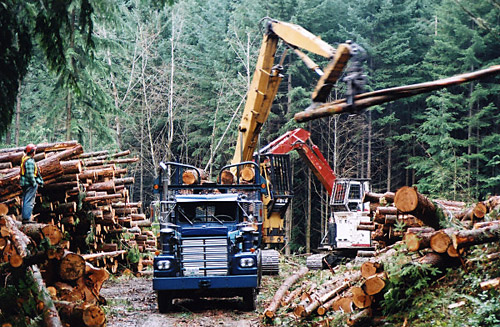
Harmon’s response to questions on leakage was to acknowledge that the delay in harvest would result in some leakage and that the change in rotation age might need to be phased in over time. He felt their acknowledgement in the paper that it might happen was adequate.
Given the expected leakage, the net benefit of nearly doubling the rotation age must acknowledge that carbon benefits will be delayed many decades. This delay is not trivial.
The IPCC has indicated the world should try not to cross the 2-degree increase threshold, which the paper acknowledged. That is about 450 ppm of carbon in the atmosphere.
Alan Organschi, in his presentation at the IMTC 18, indicated that temperature increase will occur in about 18 years without significant changes in behavior. Therefore, the carbon benefits of longer rotations, while potentially real in the long run, will have minor or no benefits in the next few decades.
The sequestration of carbon in wooden buildings, however, provides immediate benefits.
Bruce Lippke, professor emeritus at the University of Washington and former executive director of CORRIM said, “The substitution benefits of wood in place of steel or concrete are immediate, permanent and cumulative.”
Both scenarios seriously question the validity of the Law paper’s conclusion that there would be any increase in net carbon by 2025 or 2050, let alone the 56 percent increase in net carbon by 2100.
However, the idea that longer rotations could store more carbon than shorter rotations is valid and has been known for many decades, so there is an opportunity for some real carbon gains.
How can we potentially take advantage of this? This goes to the triple bottom line. How can the significant social and economic impacts of such a dramatic change in harvest from the private lands be incorporated? Could a plan to mitigate mill closures, lost logging jobs, and decreases in property and income tax bases be developed? Could Oregon use alternate sources of wood for the transition? Law did not mention these challenges.
In my discussion with Harmon, I raised these issues and asked if part of a discussion to explore how to provide more wood to manufacturers and avoid the disruption might be to harvest through thinning and variable retention harvest prescriptions on national forest lands where there is an abundance of plantations regenerated in the 1950s through the 1980s, so there would be a supply of 80-year-old trees coming available soon.
He didn’t endorse the idea, but thought it could be explored. He then offered that more harvest might occur on the eastern side of the Cascade Mountains to reduce the density of those forests and provide some of the supply.
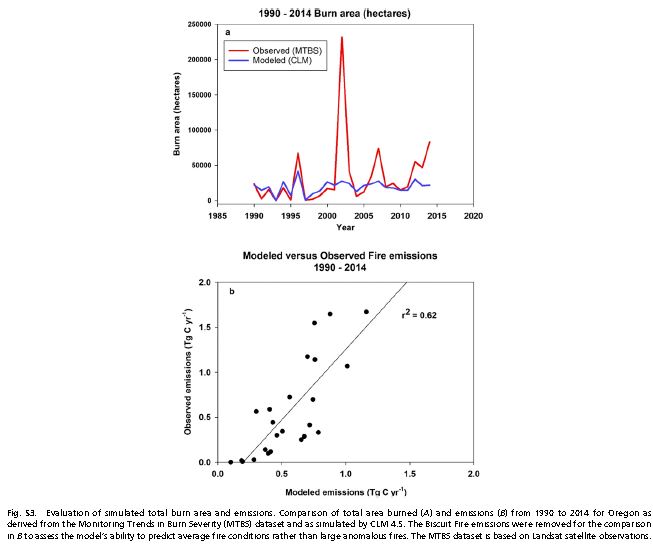
Assumptions – Wildfire Behavior
Another assumption in the paper begged questioning and that was related to the model for predicting wildfire emissions.
The authors chose to treat the largest fire in their 25-year calibration period, the Biscuit Fire (2003), as an anomaly. Yet 2017 provided a similar number of acres burned.
As seen in Figure S3 above, the model also significantly underestimated five of the six other larger fire years illustrated in the graph. The net result is a substantially lower amount of fire-generated carbon emissions modeled than what actually occurred.
The paper also assumed no increase in fires in the future, which belies the results of climate change across the western U.S. over the past 20 to 30 years and the predictions by fire and climate scientists for the coming decades across the U.S. No rationale for this assumption was presented.
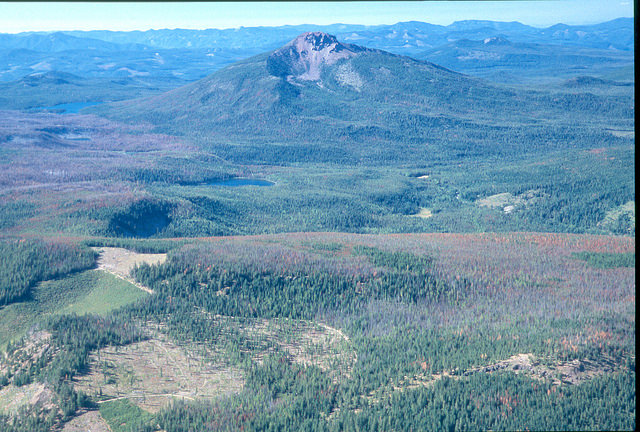
Assumptions – Insect and disease mortality
In addition to underestimating fire emissions, the modeling essentially ignored the time, scale and pattern of insect and disease mortality in the forests, which in turn overestimated the carbon stored in the forest.
Their model included only one bark beetle (mountain pine beetle) as a very small annual mortality factor (0.1 percent per year), rather than the episodic landscape-scale mortality that the beetle actually produces.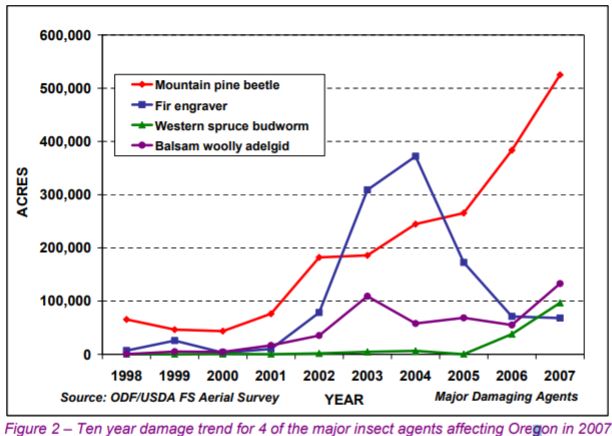
Spruce budworm, Douglas fir tussock moth and other bark beetles were not modeled at all. Again, this decision inflates the amount of carbon stored by unharvested forests.
A 2008 paper by Dr. Chris Hennigar, a faculty member in Forestry and Environment Management, University of New Brunswick, and another paper he co-authored with Cameron et al. in 2013 looked at forests in eastern Canada.
Hennigar modeled the growth and management of the forests, examining the tradeoffs between carbon stored in the forest versus the harvest and use of wood products. The first was a theoretical forest. The second paper modeled actual industrial timberlands with multiple mills that relied on the supply. Finally, he modeled no harvest for comparison.
Both papers concluded it is essential to account for all carbon pools: in the forest, in products, in landfills, substitution benefits. Leakage and the probability of natural disturbances also must be considered, the authors said.
In an email, Hennigar shared his overall perspective: “In my opinion, the best use of trees for reducing global C emissions is when used for structural wood products and bioenergy. Making lumber is actually extremely efficient, as most energy for the mill comes from lumber residues. The pulp and paper sector is often ignored in these lumber substitution studies, yet making paper has an order of magnitude higher level of carbon emissions compared to making lumber. If this low-grade material can be used to avoid coal and natural gas use, then you get an added energy substitution benefit.”

Assumptions – Building Life Span
The Law paper assumes a 2 percent annual loss rate for buildings or about an average 50-year half-life, but is a function that front-loads demolition. It also means that 2 percent of the buildings are demolished in year one of the model cycle, year 2 and 3, and so on.
Oneil says, “Asserting that buildings fall apart at a 2 percent/year lost rate isn’t defensible given the literature on building life.” In typical LCAs, the demolition of buildings doesn’t start for 30 years. This building life assumption is quite pessimistic.
Information provided by U.S. Forest Service research indicates the ASTM E2921-16A standard for building lifespan states in criteria 6.1.1: “Unless otherwise specified by the applicable code, standard or rating system, the building service life shall be no less than 75 years.”
A report published by the Athena Institute in 2004, looked at actual building demolition over a three-plus-year period in St. Paul, Minn. It indicated 51 percent of the buildings were older than 75 years. Only 2 percent were demolished in the first 25 years and only 12 percent in the first 50 years.
Law’s paper indicates that more than half would be gone at 50 years.
The Athena report also found that buildings made out of wood had longer lives (67 percent >75 years) than those made from steel (10 percent > 75 years) and concrete (17 percent > 75 years).
The implication of the substitution benefits by the differential lifespan magnifies the beneficial effect of using wood.
The Law paper assumes that the life of buildings will get shorter in the future rather than longer. In reality, architects and engineers are advocating the principle of designing and building for longer time spans – with eventual deconstruction and reuse of materials rather than disposal. Mass timber buildings substantially enhance this capacity.
There are Chinese Pagoda temples made from wood that are 800 to 1,300 years old. Norwegian churches are over 800 years old. I visited at cathedral in Scotland with a roof truss system from the 1400s.
Buildings made of wood can last for many centuries. If we follow the principle of designing and building for the long run, the carbon can be stored for hundreds of years.
Instead of assuming a shorter and shorter life-span of buildings, we need to install incentives and rewards for longer and more durable systems in our built environment.
If many species of trees can live and stand for hundreds of years, there is no reason our cities can’t do the same. It seems a sensitivity analysis using a range of lifespans from their pessimistic 50 years to the status quo (75-year minimum in the ASTM) to something longer (perhaps a more optimistic 100 years or more) would have been a valuable exercise to reflect the consequences of those choices.
The Bullitt Center in Seattle used Living Building Challenge principles and was designed and built for a 250-year life span.
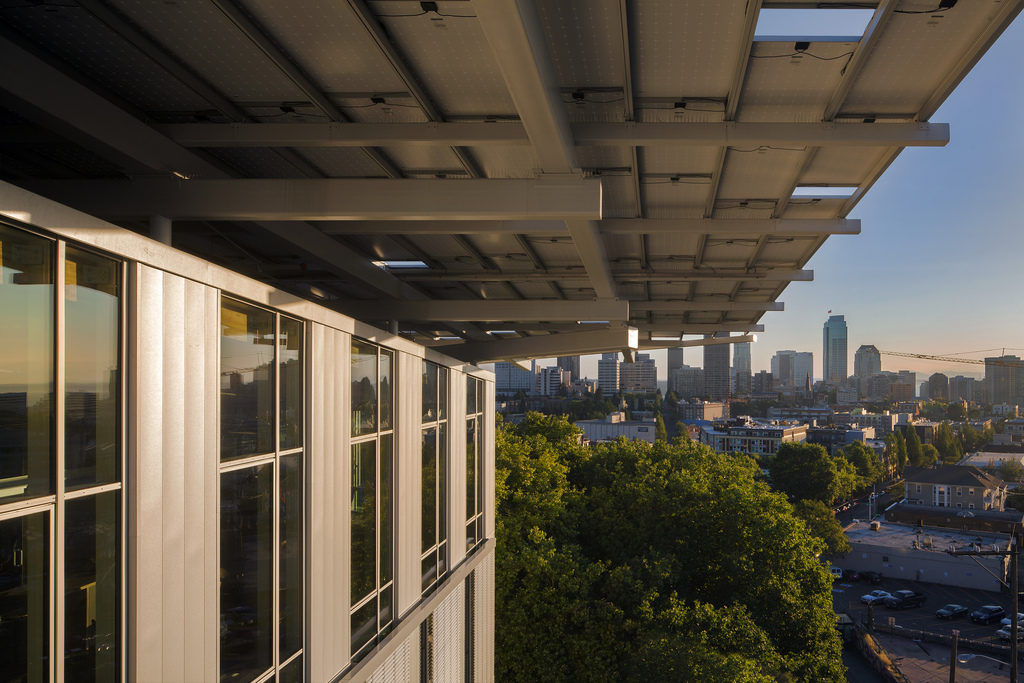
Assumptions – substitution benefits
The LCA experts told me the substitution benefits of wood over steel are not lost or degraded over time, and the carbon gains are immediate and permanent.
Oneil put it this way: “That decision to build with a given bill of materials (wood, concrete, steel, etc.) is a permanent decision. You either do or you don’t. Even when you demolish that building, you have still made the decision to substitute wood with a negative carbon footprint, for a material that emits more carbon than it stores. It is irreversible. It is like being born; once you are born, you can’t be unborn. Even after you die, you still existed and have left a permanent mark on the world. Both Ghandi and Hitler are dead, but what they did is irreversible. It changed the course of history forever.”
Harmon, one of the authors of the PNAS paper and the lead on the carbon stores analysis, told me he inserted a reduction in the substitution carbon store for three reasons: “The fossil carbon not used [for steel and concrete] could be mined and used for other purposes,” which is interesting since his analysis chooses to account for a form of fossil fuel leakage, but chooses not to model any wood harvest leakage.
Harmon doesn’t accept the idea that as people and utilities install more renewable energy, more efficient cars and the like, that fossil carbon release will be avoided.
He said all the projections he knows of “indicate all the fossil carbon will be consumed.” In his view, the world will use all of its oil and gas reserves in 50 to 75 years and coal reserves in 150 to 200 years, so at best these actions will only delay the ultimate exhaustion of fossil fuels.
This thought process is in sharp contrast to the notion that we are in a several-decade transition away from fossil fuels. It is already underway, through the development of renewable energy sources, using less steel and concrete, electric cars, solar, wind and more.
It ignores the fact that states on both the Pacific and Atlantic coasts will not accept drilling for offshore oil and gas, which means that fossil oil and gas carbon is locked up.
It ignores the fact that some states have banned fracking, locking up natural gas carbon. It ignores the fact there were 531 coal-fired plants closed between 2007 and 2016 representing 55.6 gigawatts of power, and another 27 (22 GW) closed in 2017 without any new utility scale plants being built.
Many of the recent closure decisions have been driven by economics, where wind and sometimes solar are cheaper than operating coal-fired plants.
He ignores the fact that the new export terminals for coal in western Washington are not going to be built (lawsuits pending), so there will not be an expansion of coal exports. Even China is building gas-fired plants instead of using coal.
Yale e360 published a paper highlighting the cities (representing 25 percent of the global GDP) and corporations (760 representing $15 trillion) across the country and the world that are committed to the Paris Accords and to significantly reducing carbon emissions.

All of these actions indicate a trend away from fossil fuels is underway and gaining momentum. The more realistic expectation is that not all fossil fuels will be utilized and that concerted efforts across all sectors to reduce their use is essential to achieve the synergistic goal of reducing GHG emissions.
Of course, things are not all “green,” as Congress recently authorized the opening of the Arctic National Wildlife Refuge to the potential for drilling, but that is likely a decade and many lawsuits away from actual production.
Harmon’s second defense for a 2-percent loss factor of the substitution benefits is that there must be a relationship between the building store/lifespan of carbon and the substitution carbon.
He didn’t explain what that relationship is, just that it must exist.
LCA specialists say when you choose to use a lower energy material like a wood floor joist instead of steel, the energy saved doesn’t go away when the building is demolished.
Harmon says, “If you use that logic, the potential fossil energy savings is infinite, which would be more than what is in the ground and that is not possible.”
Oneil’s response: As long as there are fossil energy alternatives, the decision to use them or not is there and the potential for a substitution benefit. If we stop using fossil fuels, then there is no substitution benefit. The only carbon benefit wood will have over steel and concrete is the carbon stored in the wood.
The third reason given for the 2 percent annual loss is that it is needed to take into account the initial condition, the past building history.
Oneil says that is outside of the boundaries of the LCA analysis. The decision in the past to build with steel, wood or concrete doesn’t affect the decision of what to build with today. Any substitution benefit decision made today results in a fossil carbon savings today that don’t go away.
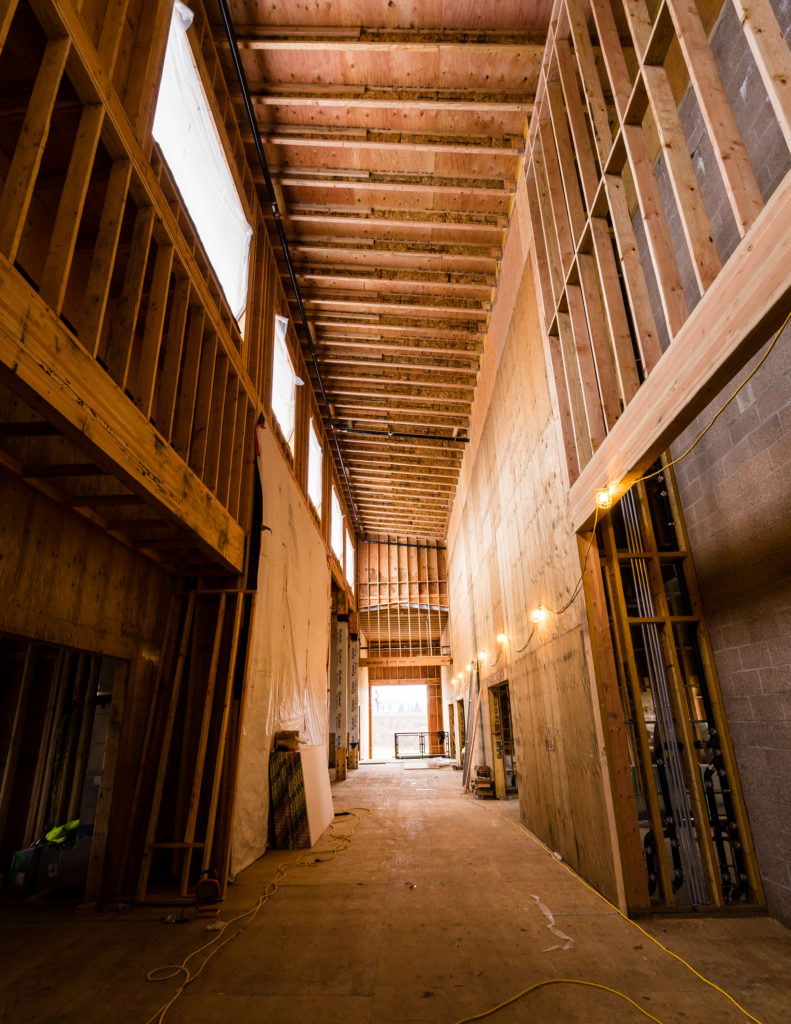
Looking ahead
At the end of my conversation with OSU’s Dean Davis, I asked what his advice to the public would be regarding the built environment.
When I asked Dean Davis what his advice to society would be he said, “I think it is important to use more wood in construction, for a lot of reasons. … It can be locally produced. It can be grown sustainably. We know that we can harvest and regrow forests repeatedly over time. We need to get our cities on line constructing buildings that are looking toward the future.
“Wood is a beautiful material … that can come from intensively or less intensively managed forests. All of those forests provide wildlife habitat, clean water and clean air, and opportunities for recreation while still helping support rural economies. Some trees will become long-lived stores of carbon in the forest and some will be harvested to make beautiful buildings that store carbon in urban settings.”
Near the end of each of my two conversations with Harmon, I asked him the same question. He didn’t want to answer it, saying it was a “set-up, that not all wood is sustainably grown and thus the use of wood might not be better.”
I reiterated that it would need to be sustainably grown and he indicated that was hard to determine “as there was greenwashing out there and that harvesting old-growth was not sustainable.”
I asked about the private lands where there isn’t any old growth to be harvested and which were the primary focus of the Law paper. These lands are on their second and in some places third harvest and were being managed for sustainable wood production.
He was reluctant to say that using wood was preferable, which was fascinating because the Oregon Wild leaders acknowledged the benefits of using wood, with the caveat that it not be from clearcuts. Harmon would not answer the question.
We returned to the idea of longer rotations and he acknowledged the leakage would be an issue in transitioning to the longer rotation, and society would need to explore ways to achieve that transition.
I asked if he thought part of the exploration of ideas could include harvesting more from the hundreds of thousands of acres of federal forest plantations created in the 1950s to 1980s, with thinning and variable retention harvest prescriptions that might provide additional volume as some private lands would lengthen their rotation.
He wouldn’t agree to that being desirable, but said it should be explored. He also offered the idea that more harvesting from the drier forests east of the Cascade Divide where there is a buildup of dense forests might be considered to help provide additional wood supply to fill the leakage gap.

spaces, apartment units and community areas. Photo: Ankrom Moisan Architects
Theoretical models vs. practice
Harmon and Law, as research scientists, have the luxury of defining their hypothetical analysis problem and which assumptions to use, but Clackamas County Commissioner Ken Humbertson is looking at the ”matrix” lands in the Northwest Forest Plan.
I visited with him at the IMTC 18 conference and then a couple of his county staff afterwards. They are trying to thread the real-world needle of diverse constituents with diverse and sometimes contrary perspectives by convening a number of environmental groups and industry leaders to develop a set of prescriptions that the parties could agree to for harvest on Forest Service lands in their county.
They are trying to find the sweet spot of more harvest from these matrix lands, which has not occurred to the level projected in the original Northwest Plan, and the potential of a new manufacturing plant in their area to create jobs making CLT, while reducing the use of steel and concrete with those associated benefits.

They are seeking action that can make the forest more diverse with ecologically based harvest prescriptions, produce more lumber and create jobs and additional tax base, all while retaining the old growth in the “long-term successional reserves” on the national forest.
Occam’s Razor, the simplest answer (it doesn’t mean the answer is simple or easy) and minimizing assumptions approach points in Peter Moonen’s (presenter at IMTC 18) Four “S’s”.
To wit:
Growing trees sustainably (Oregon requires regeneration after harvest, having heeded the Lorax’s advice of planting new forests).
Sequestering it in the forest where trees continually pull carbon dioxide from the air.
Store some of the captured carbon for the life of the building by using some of those trees for construction material.
Substitute renewable, low-fossil energy wood for high-fossil energy steel, concrete and brick, providing immediate long-term carbon benefits. There are no assumptions here. These are measured results.
Compare that with assuming there will be no leakage of trees being cut elsewhere if they are not cut in Oregon; assuming the life-span of buildings will get shorter than current measurements attest; assuming fires will be smaller than they have been in the past 25 years and will not get larger in the future; assuming all fossil fuels will be depleted, that the development of renewable energy will not overtake fossil fuels, that using wood in place of fossil energy intensive material will not reduce fossil fuel use.
There is that earworm again, “If you don’t grow it, you mine it!” That is my bias – a very conscious one.

Great article- very thorough.
Joe
Should be required reading for anyone who claims to be an environmentalist.
The problem is- they won’t read anything that doesn’t agree with their predetermined “truth”- which is why I call such critics “anti forestry fundamentalists”. They are zealots. The funny thing is that I’m also a big critic of bad “forestry”- which is all too common. But my solution is to stop doing it poorly and do it much better- not to stop forestry. The critics think the solution is to stop all forestry.
I seem to recall that Beverly Law was one of the coauthors of the “Donato Report” concerning salvage logging on the Biscuit Fire area. It was also very controversial due to assumptions.
Well done. This thorough review of assumptions behind the Harmon and Law paper is quite helpful. Thank you.
There have been papers showing near high leakage when harvests are delayed or reduced for different reasons (even in modeling of IFM carbon project implementation at the regional scale, which is troubling). It of course depends on the setting and alternative fates and materials. There have also been cases in which there is less substitution than expected when wood is used. So it is not helpful when the assumptions are opaque or inadequate, and the conclusions broadly generalized. The devil is in the details or assumptions, resolved through a good LCA as well as a deep understanding of the ecosystem from which the carbon is removed.
Thanks again.
A fascinating article which resonates with those of us involved in forestry in southern Australia where environmental activism is similarly campaigning against logging on the basis of it supposedly exacerbating climate change by releasing forest-stored carbon.
Similar to what the article describes, these campaigns are also drawing support from dubious forest carbon research particularly emanating from the Australian National University which has since 2008 claimed that forest logging releases carbon without even considering the broader context of consequences with worse climate change implications such as importing hardwood from poorly managed SE Asian forests, and the ‘substitution effect’ of forcing greater use of non-wood materials that embody a far bigger carbon footprint in their production and manufacture.
The question that is being seriously considered here is whether or not the scientists producing this dubious research may be colluding with environmental activist groups (ENGOs) to assist their campaigns. Given the manner in which this research has at times been funded by ENGO partners; has often been publicly launched by the scientists at ENGO public events; and is aggressively disseminated via the media timed to match ENGO campaigning; the prospect of collusion is considered to be a very real possibility.
The end result is the dominance of an anti-timber industry narrative that influences a significant portion of voters and potentially the political direction of parties forced to deal pragmatically with the consequences. Picking through errant forest carbon research to unearth its dubious or wrong assumptions, false citations, and outrageously poor peer review is a necessity, but unfortunately this takes time and with it comes the likelihood that the mainstream media will have little interest in publicising findings which might challenge what has already become accepted as the conventional wisdom on forestry and carbon.
Agree, this is an important article – one that gives us an approach to think simply about an issue we need to make a decision on now if we are to keep within climate limits. It’s difficult for people who have spent their lives protesting against unsustainable logging to support sustainable forestry but it is time to get on board because the climate train is leaving the station.
Bob Perschel
Great article!
As a student in the forestry program at WVU in 2003, I was lucky to have a professor who led us to analyze the Sierra Club’s report: Seeing the Forests For Their Green. The cherry-picking of data was flagrantly abusive to any form of truth that might be included in the report.
I notice that you have a lot of respect for the climate change ideology championed by the Sierra Club…it is my firm belief that the zero-cut policies and vast wilderness areas established by Clinton and Gore in the 1990’s are the main drivers of the ever-increasing wildfire problem in the US. (For which climate change is loudly blamed at every turn)
I’m also afraid it was intentionally designed to be so. In 1991 at the Earth Summit in Rio, the decision was made to abandon truth and reason in favor of fear-mongering and goals of economic collapse for industrialized nations.
Climatology was hi-jacked by these folks. Anyone with doubts or a desire to be truthful was drummed out–check out Dr Fred Singer.
Michael Creighton wrote a shocking, eye-opening book on the subject of the environmentalists’ (new world order) agenda and data manipulation called “State of Fear.” He DIED shortly thereafter.
It’s very sad to see environmental organizations taken over by lawyers and special interests–being used for anti-people agendas rather than rooting for the power of ingenuity and real solutions. Dr. Patrick Moore-formerly of Greenpeace is slandered daily by these hatemongers.
I am really glad to see that people are starting to question what the are being told by our elitist leaders and lawyer-laden environmentalist organizations who actively seek to misinform with data-spin.
THANK YOU